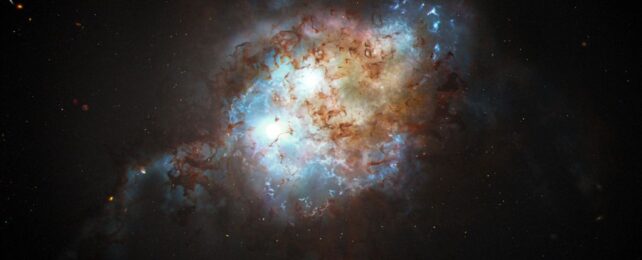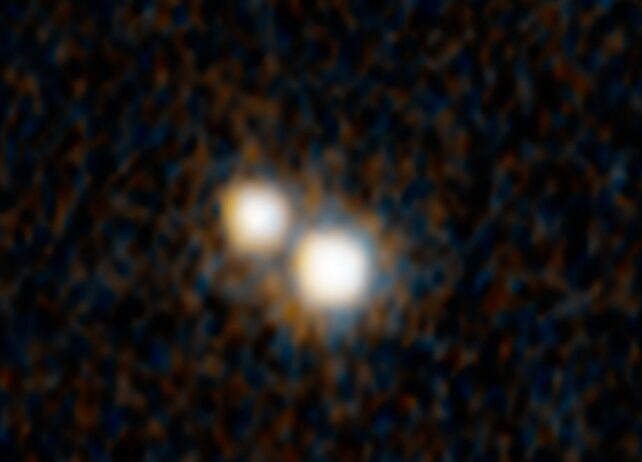
Astronomers have discovered a cosmic smash-up just waiting to happen in a giant object just 3 billion years after the Big Bang.
A galaxy called J0749+2255 actually consists of two galaxies merging into one, and it has not one but two actively feeding supermassive black holes. It just so happens these two black holes are on a collision course, separated by a relatively tiny distance of just 10,000 light-years.
It's not the first time we've seen an impending supermassive black hole collision, but J0749+2255 is a rare gem. It's been spotted early in the Universe, and both black holes are extremely active quasars.
It's a discovery that can help scientists work on the ongoing and vexing puzzle of how supermassive black holes grow to such tremendous sizes.
"We don't see a lot of double quasars at this early time in the Universe. And that's why this discovery is so exciting," says astronomer Yu-Ching Chen of the University of Illinois at Urbana-Champaign.
Quasars are among the brightest objects in the Universe. They contain an active galactic nucleus – the center of a galaxy hosting a supermassive black hole that is actively gulping down vast amounts of material.
Black holes emit no light of their own that we can currently detect. The massive amount of material swirling around the black hole is heated by extreme friction and gravity so that it doesn't just shine but blazes across the vast dark gulfs of time and space.
Many early Universe galaxies are quasar galaxies, and some in the nearby Universe have two or even three quasars in their center. This occurs when galaxies collide and merge, each with its own supermassive black hole. The two black holes fall towards each other, eventually – we think – merging to form one very large supermassive black hole.

But these mergers are a bit harder to spot in the early Universe. The light from J0749+2255 has traveled for more than 10 billion years to reach us; what we see of the galaxy is quite small and dim compared to the stuff that's a lot closer to us. At that distance, the space between supermassive black holes that are bound together by gravity is usually too small for our current instruments to see
A faint variation in the light from J0749+2255 detected by the Gaia telescope suggested that there might be something more going on with the galaxy than was immediately apparent… but there were multiple possible causes, of which double quasar was one. The team had to dig a lot deeper to find out what was really happening.
"The confirmation process wasn't easy, and we needed an array of telescopes covering the spectrum from X-rays to the radio to finally confirm that this system is indeed a pair of quasars, instead of, say, two images of a gravitationally lensed quasar," says astronomer Yue Shen of the University of Illinois.
And J0749+2255 is special. Since both the black holes are quasars, they shine brightly enough to be able to distinguish. And they're not quite close enough, yet, to be a gravitationally bound binary, meaning they have enough separation for individual resolution.
Using observations from a whole slew of ground- and space-based telescopes, Chen and his colleagues analyzed the light from J0749+2255. They determined that the two black holes will likely evolve into a gravitationally bound tight binary in around 220 million years or so. The decaying orbit of this binary will eventually lead to a collision and merger into an even more massive black hole.
(They've probably collided by now, but that event is meaningless to us in the here and now; this is why astronomers make such predictions in the present tense.)
Researchers also found that the two black holes are relative chonkers, clocking in at around 1.26 billion solar masses and 1.58 billion solar masses, respectively. These findings could start to tell us something about the rate of binary supermassive black holes in the early Universe – which would help astronomers understand the evolution of recent black holes that can be many billions of solar masses in size.
There's still much more to uncover, but J0749+2255 represents a significant step forward.
"We're starting to unveil this tip of the iceberg of the early binary quasar population," says astronomer Xin Liu of the University of Illinois at Urbana-Champaign.
"This is the uniqueness of this study. It is actually telling us that this population exists, and now we have a method to identify double quasars that are separated by less than the size of a single galaxy."
The research has been published in Nature.





No comments:
Post a Comment